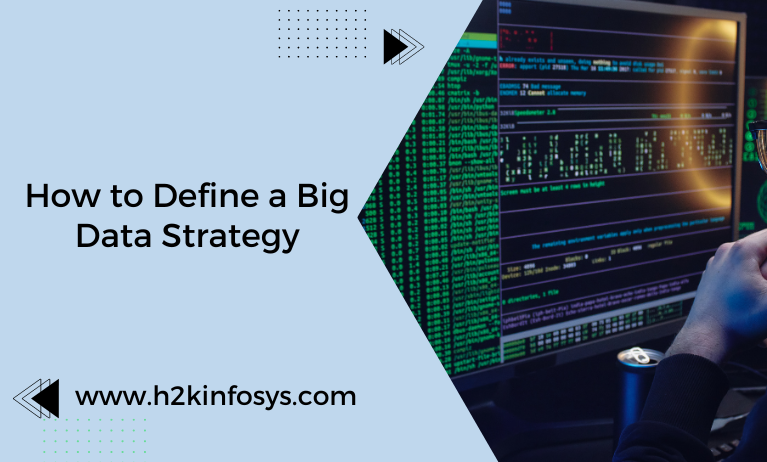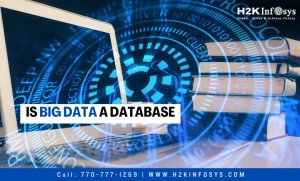Businesses can significantly increase their competitive advantage in the market by implementing a comprehensive big data strategy across the entire organisation. However, a big data strategy cannot be viewed as something apart from the corporate strategy and must be deeply ingrained. When we talk about a big data strategy, we actually mean a big data-integrated business plan.
A big data strategy establishes a framework for the business to use data-related or data-dependent capabilities by defining and outlining a complete vision across the enterprise. The advantages of big data become useful for the business when they are incorporated into a clear and complete big data strategy. The steps that should be taken by a company to become a “Data-Driven Enterprise” are outlined in this document. The Big Data strategy includes guiding principles to realise the data-driven vision, directs the organisation to choose precise business objectives, and serves as the foundation for data-driven planning across the enterprise.
Enterprises need a Big Data strategy since it crosses organisational boundaries in addition to the benefits of attaining a competitive edge. Enterprises will be compelled to cope with a range of data-related operations without a Big Data strategy, most likely started by several business divisions. Without considering the overarching long-term strategic objectives, several departments are likely to start up their own analytics, business intelligence, or data management programs. To learn more about Big Data strategy, you can check out the online Big Data training.
The combination of either the CEO/CIO (when big data defines the organisation) or the COO/CIO (when big data optimises the enterprise) should be the driving force behind the design of an enterprise big data strategy. This acknowledges that the data is a corporate asset for the entire firm as well as an IT asset.
For organisations, a well-defined corporate Big Data strategy should be implementable. Organisations can design their big data strategy using the following 5-step process to help them achieve this:
- Define business objectives
- Execute a current state assessment
- Identify and prioritise Use Cases
- Formulate a Big Data Roadmap
- Embed through Change Management
Each of the steps to formulate a Big Data strategy is explained in further detail below.
Step 1: Define business objectives
Any corporation must first completely comprehend its corporate business objectives before it can use big data effectively. What factors determine a company’s success? The achievement of or exceeding company Key Performance Indicators (KPIs) frequently leads to increased revenues and profitability. Before investigating how Big Data technology and solutions could improve performance in the future, start by understanding what makes a company effective.
Given that the main goal of big data is to create value by exploiting data, the big data strategy should be in line with corporate business objectives and address major business issues. Given that most firms already have this process in place, one method to achieve this is to align it with it.
The participation of major company stakeholders is crucial for determining corporate objectives. Make sure that these parties are included from the beginning and continue to offer important advice. Important parties to take into account in this initial step are:
Executive sponsors: Finding and working with executive sponsors is crucial, and this cannot be overstated. Through the highs and lows of developing and putting into practice the Data Strategy, their support is crucial.
The team has the right talent: Determining the correct company objectives requires involving people with the appropriate skills and skill sets. Investigate both internal and external consultants.
Potential trouble makers: Some “stakeholders” in every project or endeavour will be resistant to change, whether on purpose or accidentally. Knowing who they are, and their motivations upfront will help later in the process.
Step 2: Execute a current state assessment
The main goal of this step is to evaluate the enterprise’s present business processes, data sources, data assets, technology assets, capabilities, and policies. This exercise is meant to assist with a gap analysis between the current state and the planned future state.
As an illustration, the current state evaluation would cover any business process, data assets including architecture, capabilities (business and IT), and departmental policies that have an impact on customers if the goal of the data strategy is to obtain a 360-degree perspective of existing and potential customers. Employees that are involved in client acquisition, retention, and processing are often interviewed in a series as part of the current state assessment process.
It’s critical to find and support some data evangelists at this stage. These individuals may already be utilising the data and analytics in a potent manner and genuinely believe in the potential of data in decision-making. It is simpler to create the roadmap later on by including these folks and soliciting their input.
Step 3: Identify and priorities Use Cases
By creating Use Cases that are in line with the business objectives from step 1, visualise how predictive analytics, prescriptive analytics, and ultimately cognitive analytics (further described in chapter 8) can enable the organisation to accelerate, optimise, and continually learn. Record each Use Case to comprehend how Big Data may accomplish the corporate goal.
A clear and efficient way to explain how Big Data technology and solutions may accomplish business goals is through well-defined use cases. Prioritising each Use Case based on its business impact, resource needs, and budget comes after the Use Cases have been defined. Enterprises can determine which Big Data efforts offer the greatest business value by undertaking this exercise.
A Prioritization Matrix is one of the best tools for prioritising Use Cases. The Prioritization Matrix facilitates discussion and debate between business and IT stakeholders to identify the “right” use cases to launch a big data initiative—use cases with both significant business value (from the perspectives of business stakeholders) and reasonable feasibility of successful implementation.
An outstanding management tool for encouraging organisational alignment and commitment around the organisation’s highest priority Use Cases is the prioritisation matrix.
Step 4: Formulate a Big Data Roadmap
The following step will undoubtedly take up the bulk of time while developing a data strategy because it is the most demanding and heated phase. The Roadmap can be created based on the identified and prioritised Big Data Use Cases and the existing capabilities status evaluation (steps 2 and 3). The Big Data Roadmap describes which initiatives (or Use Cases) will be carried out initially and what capabilities (knowledge, tools, and data) will be enhanced over the following three to five years.
The Roadmap should concentrate on identifying gaps in data architecture, technology and tools, processes, and of course people (skills, training, etc.) with the intended future state in mind. There are numerous strategic alternatives for initiatives and the Use Cases will offer the current state assessment and the next task is to prioritise these options based on complexity, budget and potential benefits.
It will be important for the sponsors and stakeholders to prioritise these projects. A roadmap to implement the priority Big Data activities is the phase’s final output.
Step 5: Embed through Change Management
Change Management, which involves the hearts and minds of people, will have a significant impact on the success or failure of a Big Data strategy even though it isn’t strictly a part of the process of developing one.
Organisational change, cultural change, technology change, and modifications to business processes should all be included in change management. Change management increasingly depends on data governance, which deals with the general management of data’s availability, accessibility, integrity, and security. Any change management program should include relevant incentives and ongoing metrics.
Conclusion
Visit the Big Data online training to learn more about Big Data Strategies and how it is important in a business.
Tags: Big Data Hadoop Online Training, Big Data Hadoop at H2k infosys, Big Data Hadoop,
Big Data Hadoop Online Training and 100% job guarantee courses, H2K Infosys,






























